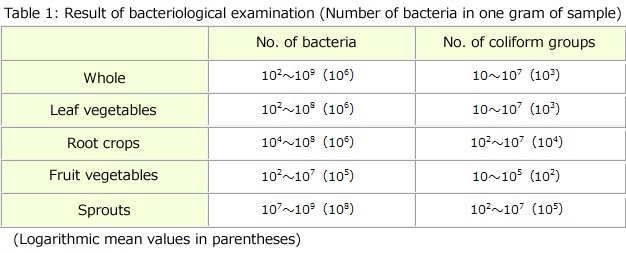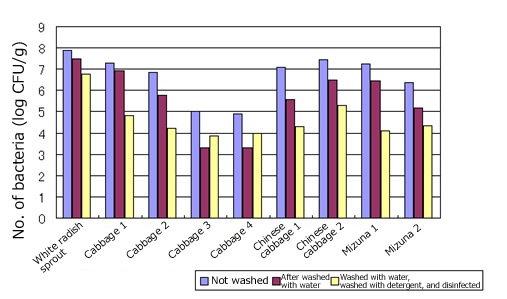Tokyo Food Safety Information Center » Tokyo Metropolitan Government food safety FAQ » I hear that food poisoning bacteria may be detected from raw vegetables. Is it true?
I hear that food poisoning bacteria may be detected from raw vegetables. Is it true?

I hear that food poisoning bacteria may be detected from raw vegetables. Is it true?

-
Ministry of Health, Labour and Welfare investigations report food poisoning bacteria are rarely detected from vegetables.
-
However, because food poisoning cases have occurred from vegetables and products processed therefrom in the past in Japan, keep vegetables, especially those consumed without heating, at low temperatures and sufficiently wash them with water prior to use.

<Result of fact-finding investigations into contamination of vegetables, etc., by food poisoning bacteria>
- Every fiscal year, the Ministry of Health, Labour and Welfare makes a fact-finding investigation into contamination of vegetables, etc., by food poisoning bacteria and discloses the results.
- According to the results, it is rare to detect Salmonellae genera and enterohemorrhagic E. coli from vegetables.
- On the other hand, Tokyo Metropolitan Government investigations into 237 samples of vegetables for eating in raw conditions and distributed in markets, food poisoning bacteria were detected from 11% of the whole (27/237) (investigations conducted from FY 2009 to FY 2011). The details of the detected food poisoning bacteria are as shown in the figure below:


< Washing reduces number of bacteria.>
- By using nine samples of vegetables, etc., that were edible in a raw state (details: One sample of white radish sprouts, four samples of cabbages, two samples of Chinese cabbages, and two samples of mizuna or potherb mustard), the Tokyo Metropolitan Government examined how many bacteria were reduced by washing (investigations conducted from FY 2009 to FY 2011).
- As a result, both “washing with water only (washing with running water three or more times)” and “washing with water and neutral detergent and then disinfection with sodium hypochlorite*” reduced the number of bacteria from every sample.
* Methods of washing and disinfection:
- Washing with running water three or more times
- Soaking in neutral detergent solution for three minutes and then sufficiently washing with running water
- Soaking in sodium hypochlorite solution (100 mg/liter) for ten minutes and then sufficiently washing with running water

< At home, store vegetables at a low temperature and wash them well.>
- Store cut vegetables, leafy vegetables, sprouts, and the like at a low temperature (10℃ or so) not to increase bacteria.
- Sufficiently wash vegetables with running water. In particular, carefully wash vegetables to eat without heating.
- Some cut vegetable products for salads are washed in the factory. Check the label to find if the cut vegetable product is factory-washed.